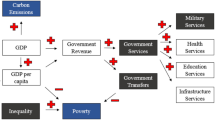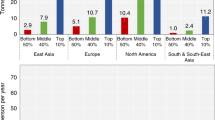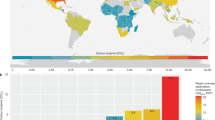Abstract
It has long been assumed that human development depends on economic growth, that national economic expansion in turn requires greater energy use and, therefore, increased greenhouse-gas emissions. These interdependences are the topic of current research. Scarcely explored, however, is the impact of international trade: although some nations develop socio-economically and import high-embodied-carbon products, it is likely that carbon-exporting countries gain significantly fewer benefits. Here, we use new consumption-based measures of national carbon emissions1 to explore how the relationship between human development and carbon changes when we adjust national emission rates for trade. Without such adjustment of emissions, some nations seem to be getting far better development ‘bang’ for the carbon ‘buck’ than others, who are showing scant gains for disproportionate shares of global emissions. Adjusting for the transfer of emissions through trade explains many of these outliers, but shows that further socio-economic benefits are accruing to carbon-importing rather than carbon-exporting countries. We also find that high life expectancies are compatible with low carbon emissions but high incomes are not. Finally, we see that, despite strong international trends, there is no deterministic industrial development trajectory: there is great diversity in pathways, and national histories do not necessarily follow the global trends.
This is a preview of subscription content, access via your institution
Access options
Subscribe to this journal
Receive 12 print issues and online access
$209.00 per year
only $17.42 per issue
Buy this article
- Purchase on Springer Link
- Instant access to full article PDF
Prices may be subject to local taxes which are calculated during checkout



Similar content being viewed by others
References
Peters, G. P., Minx, J. C., Weber, C. L. & Edenhofer, O. Growth in emission transfers via international trade from 1990 to 2008. Proc. Natl Acad. Sci. USA 108, 8903–8908 (2011).
UNFCCC United Nations Framework Convention on Climate Change (United Nations, 1992); available at http://unfccc.int/resource/docs/convkp/conveng.pdf.
Boden, T. A., Marland, G. & Andres, R. J. Global, Regional, and National Fossil-Fuel CO 2 Emissions (Carbon Dioxide Information Analysis Center (CDIAC), Oak Ridge National Laboratory, US Department of Energy, 2009).
Meinshausen, M. et al. The RCP greenhouse gas concentrations and their extensions from 1765 to 2300. Climatic Change 109, 213–241 (2011).
Baer, P., Athanasiou, T. & Kartha, S. in The Right to Development in a Climate Constrained World: The Greenhouse Development Rights Framework 1–95 (Heinrich Böll Foundation, Christian Aid, EcoEquity and the Stockholm Environment Institute, 2007); available at http://ecoequity.org/docs/TheGDRsFramework-first.pdf.
Cottrell, F. Energy and Society. The Relation between Energy, Social Change, and Economic Development (McGraw-Hill Book Company, 1955).
Mazur, A. & Rosa, E. Energy and life-style. Science 186, 607–610 (1974).
UNDP Energy as an Instrument for Socio-Economic Development (United Nations Development Programme, 1995).
Goldemberg, J. & Johansson, T. B. in World Energy Assessment. Overview 2004 Update 1–85 (United Nations Development Programme, United Nations Department of Economic and Social Affairs and the World Energy Council, 2004); available at http://www.undp.org/energy/weaover2004.htm.
Wilkinson, P., Smith, K. R., Joffe, M. & Haines, A. A global perspective on energy: Health effects and injustices. Lancet 370, 965–978 (2007).
Preston, S. H. The changing relation between mortality and level of economic development. Int. J. Epidemiol. 36, 484–490 (2007).
UNDP Human Development Report 2010. The Real Wealth of Nations: Pathways to Human Development (United Nations Development Programme, 2010).
Steinberger, J. K. & Roberts, J. T. From constraint to sufficiency: The decoupling of energy and carbon from human needs, 1975–2005. Ecol. Econ. 70, 425–433 (2010).
Peters, G. P. & Hertwich, E. G. CO2 embodied in international trade with implications for global climate policy. Environ. Sci. Technol. 42, 1401–1407 (2008).
Davis, S. J. & Caldeira, K. Consumption-based accounting of CO2 emissions. Proc. Natl Acad. Sci. USA 107, 5687–5692 (2010).
Hertwich, E. G. & Peters, G. P. Carbon footprint of nations: A global, trade-linked analysis. Environ. Sci. Technol. 43, 6414–6420 (2009).
Levinson, A. Offshoring pollution: Is the United States increasingly importing polluted goods? Rev. Environ. Econ. Policy 4, 63–83 (2010).
Peters, G. P. Policy update: Managing carbon leakage. Carbon Manage. 1, 35–37 (2010).
Caldeira, K. & Davis, S. J. Accounting for carbon dioxide emissions: A matter of time. Proc. Natl Acad. Sci. USA 108, 8533–8534 (2011).
Roberts, J. T. & Parks, B. C. A Climate of Injustice. Global Inequality, North–South Politics, and Climate Policy (MIT Press, 2007).
Dicken, P. Global Shift: Mapping the Changing Contours of the World Economy Sixth Edition (Sage, 2010).
Bunker, S. G. Modes of extraction, unequal exchange, and the progressive underdevelopment of an extreme periphery: The Brazilian Amazon, 1600–1980. Am. J. Sociol. 89, 1017–1064 (1984).
Unruh, G. C. & Carrillo-Hermosilla, J. Globalizing carbon lock-in. Energ. Policy 34, 1185–1197 (2006).
Stern, D. Between estimates of the emissions-income elasticity. Ecol. Econ. 69, 2173–2182 (2010).
Rothman, D. S. Environmental Kuznets curves—real progress or passing the buck? A case for consumption-based approaches. Ecol. Econ. 25, 177–194 (1998).
Suri, V. & Chapman, D. Economic growth, trade and energy: Implications for the environmental Kuznets curve. Ecol. Econ. 25, 195–208 (1998).
Wiedmann, T. et al. A carbon footprint time series of the UK—results from a Multi-Region Input–Output model. Econ. Syst. Res. 22, 19–42 (2010).
Baiocchi, G. & Minx, J. C. Understanding changes in the UK’s CO2 emissions: A global perspective. Environ. Sci. Technol. 44, 1177–1184 (2010).
UN World Urbanization Prospects: The 2007 Revision (United Nations, Department of Economic and Social Affairs, Population Division, 2008).
The World Bank World Development Indicators (World Bank, 2010); available at http://data.worldbank.org/data-catalog.
Acknowledgements
J.T.R.’s start-up research fund from Brown University was critical in the completion of this work. We thank J. Karstensen of CICERO for help with Fig. 1.
Author information
Authors and Affiliations
Contributions
J.K.S. and J.T.R. designed the research; J.K.S. and G.B. conducted the analysis; G.P.P. provided the consumption-based carbon data and feedback on its analysis; J.K.S., J.T.R. and G.P.P. wrote the paper.
Corresponding author
Ethics declarations
Competing interests
The authors declare no competing financial interests.
Supplementary information
Rights and permissions
About this article
Cite this article
Steinberger, J., Roberts, J., Peters, G. et al. Pathways of human development and carbon emissions embodied in trade. Nature Clim Change 2, 81–85 (2012). https://doi.org/10.1038/nclimate1371
Received:
Accepted:
Published:
Issue Date:
DOI: https://doi.org/10.1038/nclimate1371
This article is cited by
-
Global river economic belts can become more sustainable by considering economic and ecological processes
Communications Earth & Environment (2024)
-
Effects of foreign aid and energy aid inflows on renewable and non-renewable electricity production in BRICS countries
Environmental Science and Pollution Research (2023)
-
Heterogeneous effect of GHG emissions and fossil energy on well-being and income in emerging economies: a critical appraisal of the role of environmental stringency and green energy
Environmental Science and Pollution Research (2022)
-
Measuring economic, social and environmental wellbeing of Asian economies
Environmental Science and Pollution Research (2022)
-
The nexus between CO2 emissions, human capital, technology transfer, and renewable energy: evidence from Belt and Road countries
Environmental Science and Pollution Research (2022)



